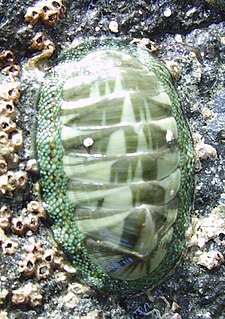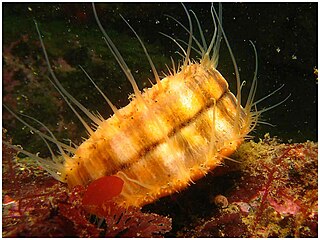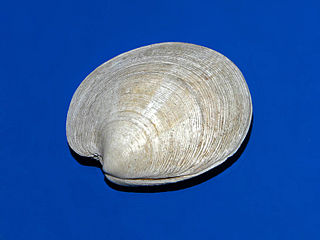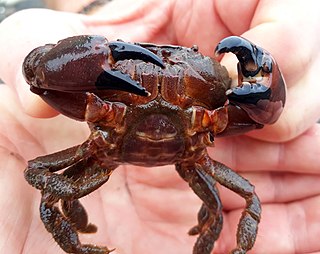
Perna canaliculus, the New Zealand green-lipped mussel, also known as the New Zealand mussel, the greenshell mussel, kuku, and kutai, is a bivalve mollusc in the family Mytilidae. P. canaliculus has economic importance as a cultivated species in New Zealand.

Eudoxochiton nobilis, commonly called the noble chiton, is a large chiton of the family Callochitonidae. The Māori name is Rangitīra.

Chiton glaucus, common name the green chiton or the blue green chiton, is a species of chiton, a marine polyplacophoran mollusk in the family Chitonidae, the typical chitons. It is the most common chiton species in New Zealand. Chiton glaucus is part of a very primitive group of mollusc with evidence of being present in up to 80 million years of the fossil record.
Ischnochiton circumvallatus is a common medium-sized species of chiton in the family Ischnochitonidae, endemic to the southern South Island and the Subantarctic Islands of New Zealand where it habits exposed rocky shores down to the low intertidal zone. Coloured light buff to light green on both surfaces, occasionally with reddish brown. Moderately raised shell and narrow girdle which has small scales. Broods larvae along the sides of the body.
Maorichiton is a defunct genus of chitons in the family Mopaliidae.

Pecten novaezelandiae, common name the New Zealand scallop, is a bivalve mollusc of the family Pectinidae, the scallops. Its name is sometimes found misspelt as Pecten novaezealandiae.

Tucetona laticostata, or the large dog cockle, is a salt water clam or marine bivalve mollusc in the family Glycymerididae.

Chlamys hastata, the spear scallop, spiny scallop or swimming scallop, is a species of bivalve mollusc in the family Pectinidae found on the west coast of North America from the Gulf of Alaska to San Diego, California. A limited number of these scallops are harvested by divers or by narrow trawls off the west coast of Canada.
Stigmella hoheriae is a species of moth of the family Nepticulidae. This day flying moth is found in New Zealand where it is rarely noticed as the species is very small and as a result does not tend to attract attention when on the wing.

Fabulina fabula, the bean-like tellin, is a species of marine bivalve mollusc in the family Tellinidae. It is found off the coasts of northwest Europe, where it lives buried in sandy sediments.

Dosinia exoleta, common name the rayed artemis, is a saltwater clam, a marine bivalve mollusc in the family Veneridae, the venus clams.

Plaxiphora albida, the white Plaxiphora chiton, is a species of chiton in the family Mopaliidae.

Plaxiphora tricolor is a species of chiton in the family Mopaliidae.

The grey warbler, also known by its Māori name riroriro or outside New Zealand as the grey gerygone, is an insectivorous bird in the family Acanthizidae endemic to New Zealand. Its natural habitat is temperate forests. It is sometimes known as the teetotum or rainbird.
Plaxiphora boydeni is a small uncommon chiton in the family Mopaliidae, endemic to the East Coast of the South Island, New Zealand, Stewart Island and the Chatham and Subantarctic Islands.
Plaxiphora egregia is a distinctive chiton in the family Mopaliidae, endemic to the South Island of New Zealand, where it is uncommon.

Plaxiphora biramosa is an uncommon chiton in the family Mopaliidae, endemic to New Zealand.

Plaxiphora obtecta is a large chiton in the family Mopaliidae, endemic to New Zealand, where it is most often found on the West Coast of the North Island. It is called Haka-hiwihiwi by some Māori and was likely a food source.

Anthopleura rosea, commonly known as the rose anemone or rock pool anemone, is a small pink anemone endemic to New Zealand.

Ozius deplanatus, commonly known as the black finger crab and the iron crab, is a species of crab found in New Zealand and Australia.














